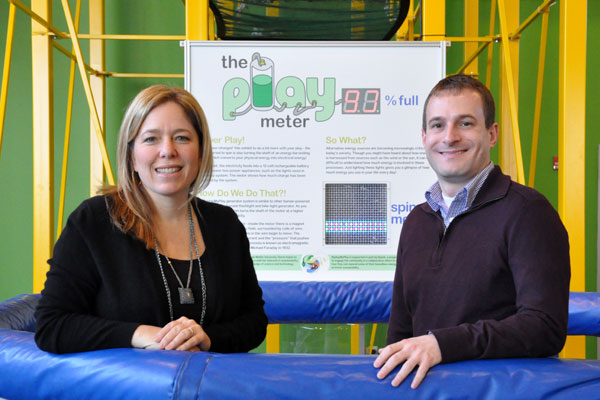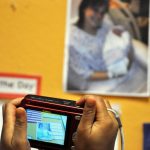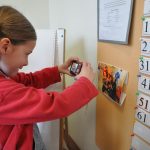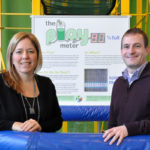
Ten tenacious years for The Sprout Fund. So what’s next?
To understand the impact of Spark — the three-year-old program of The Sprout Fund that has brought early childhood educators together with technology and new media experts to create 30 inventive projects in the region — you’ve got to realize the impact of the Sprout Fund, which has seeded more than 480 one-of-a-kind local community and arts projects for a decade now.
And to understand the power of Sprout, you’ve got to appreciate the work of leaders Cathy Lewis Long and Matt Hannigan, its executive and deputy directors since Sprout’s inception.
“They are a remarkable team,” says Gregg Behr, head of theGrable Foundation, which has provided the impetus and funding for Spark. “It’s rare that two people can simultaneously hold leadership. Cathy is a great visionary and a great advocate and public spokesperson. Matt is very detail-oriented. He implements and can get things done.”
Sprout and Spark have always been about improving the life of this region. But Sprout began with a mandate to focus on programs for young professionals, whereas Spark has ensured that “our program serves a much broader group,” says Hannigan – those who “live, work, play andraise a family” here.
The impact shows in the types of projects Spark funds, and in the way it helps grant recipients before, during and after the process. Message from Me, for instance, which was devised by Carnegie Mellon University’s CREATE Lab, uses a specially constructed interface to let some of the youngest children in pre-school, day-care and home-care programs send a text or email to their parents or guardians about what they are doing during the day. It makes obsolete the usual report children give parents about their day away – “What did you do?” “Nothing.”
Spark’s initial $15,000 has since led to a $196,600 grant from the PNC Foundation.
Spark, says Message’s Emily Hamner, “really allowed us to try out the idea. I don’t think we would have gotten this larger grant if it hadn’t been for the first grant. They definitely made it possible” – even before funding, she adds, when Spark personnel helped focus Message’s proposal and make it a worthwhile effort.
“The younger kids don’t really have a good idea of what it means to send a message to someone who isn’t there,” says Hamner. “But they’re still really excited. And the parents I talked to … really enjoyed getting the message.”
Spark, she concludes, ” gave us a lot of freedom to do what we had envisioned.” From an initial Message kiosk at CMU’s Children’s School, Message is about to expand to 30 kiosks in 13 children’s facilities in local low-income areas.
Spark has also supported Deren Guler’s effort to bring RePlayMyPlay, a project that uses playground equipment to show kids how energy is generated, to the Carnegie Science Center: “They gave me all the funding for the materials and they helped me with the contracts with the Science Center,” Guler says. “I didn’t really have that much experience negotiating contracts, especially with a museum.”
“The potential for Spark could be huge, not just for Pittsburgh but on a national level,” says outgoing Sprout board Chair Henry Simonds. He calls Cathy Lewis Long and Matt Hannigan “the yin and yang of Sprout. They’ve created one greater being [together]. I don’t think either one of them could have succeeded without the other.”
But neither Sprout nor the Long-Hannigan team was a sure thing at the beginning.
When the first county executive, Jim Roddey, replaced the three county commissioners as new leadership for Allegheny County in 2001, Roddey formed the New Idea Factory to solicit and generate fresh concepts for county improvement. Long, a Squirrel Hill native and CMU grad, was working for Oxford Development’s then-president David Matter, who co-chaired Roddey’s transition team.
Recalls Long: “I went to Roddey and said, ‘You need to appoint somebody to carry the transition team’s work forward.’ He said, ‘Great – you’re hired.’ I said, ‘No, no, not me.’ But it was one of those things you had to do.”
Hannigan, originally from Indiana but attending CMU’s Heinz College at the time, was Long’s intern. He thought he’d simply help get Sprout off the ground. In fact, he left in 2002 to join the Executive Office of the President under George W. Bush.
Hannigan lasted six weeks away from the excitement of Sprout’s new ventures. “What I found out was I really missed the opportunity to touch, see and feel change,” he says today.
“His parents thought he was crazy!” Long says.
“It felt like a risk that was too good not to take,” Hannigan says.
“It felt like a really tangible way to make a difference,” Long says. “It felt like we as a city were falling behind, and as a region.” Sprout would work “if we could create the kind of indigenous energy that will really help a city thrive—“
“—and build something from action that was authentic: something that is Pittsburgh-only, but is now easily replicable,” Hannigan says.
Ten years later, they are both still leading and expanding Sprout — and Spark.
“I live less than five blocks away from where I grew up,” Long muses. “I didn’t plan that. I feel like I’ve travelled farther in my life.”
Indeed, both leaders have. Today, more than 100 individuals and institutions have supported Sprout with $4 million, most prominently The Grable Foundation and the Richard King Mellon Foundation. Sprout’s concentration on small-scale catalytic support has helped hundreds of individuals and community groups complete a variety of projects and public art. Today there are more than 55 murals improving the visual landscape of the region, including a mammoth 10th anniversary artwork slated for the side of Downtown’s Law and Finance Building.
Sprout, Hannigan says, is most proud of projects that have used their seed money to expand programs far beyond what Sprout can directly support, such as GTECH moving from improvements to East Liberty’s vacant lots to those in New Orleans, and Bike Pittsburgh’s move from its first project – the artful, circular bike racks that still dot the city – to becoming a regional hub for two-wheeled transportation issues.
Along the way, Sprout has provided initial support to everything from Handmade Arcade and the VIA music festival to Burgh Bees. The idea, both leaders say, is to find out what communities need from the actual community, and to create new community leaders by fostering projects.
Spark’s first three years have supported projects at the intersection of new media, technology and early childhood learning for kids from birth to age 8, such as the kid-controlled Reefbot at the Pittsburgh Zoo & PPG Aquarium – a submersible that lets the children take pictures and prompts them to do research to identify their finds. Going forward, it will expand its focus to kids in higher grades, including high school.
Spark is also now supporting the Pittsburgh Kids+Creativity Network, a hub for local innovators and educators who are working together to integrate the arts with science and technology to prompt learning and creative play among children.
Long sees the expansion and shift in Spark taking it from a pure grant maker to “a network enabler to help drive the region ahead in innovative ways of helping children learn, recognizing that the way children learn today is different …”
“We want to open the doors so more people can benefit from this knowledge sharing,” says Hannigan.
Details of their plans to make Kids+Creativity more publicly accessible won’t be available until the spring – in, among other places, the spring issue of the newsletter Pittsburgh isKidsburgh.
Long has seen the impact of exciting, effective education efforts on her own children, aged 6, 3 and 19 months, when they visited the MakeShop, a new permanent exhibit at theChildren’s Museum of Pittsburgh. It brings the spirit of the city’s indie inventors, crafters and hackers (in the original, benign sense) to a work area for kids involving everything from woodworking to animation, new video technology and traditional sewing machines.
“It’s so exciting to see what happens with a child who has a piece of felt in one hand and a thread in the other,” Long says. “With some guidance, we have a finger puppet” – and a conversation started about what kids can make themselves, with a little guided ambition.
Gregg Behr of the Grable Foundation is excited about the future of Spark and Kids+Creativity. Long and Hannigan’s previous success, he says. “positions them perfectly to assume leadership for the Kids+Creativity Network going forward. They have the capacity and the time to bring new opportunity to the fore.”
Mark Broadhurst, incoming Sprout chairman, sees Spark continuing to generate “really neat ideas that are having an impact and really fulfill a need for the community. When you read these proposals, you think, who would have come up with these things?”
This story originally ran in Pop City.
Photographs of Cathy Lewis and Matt Hannigan at the Science Center’s Sports Works; and of the CMU Children’s School, copyright Brian Cohen




